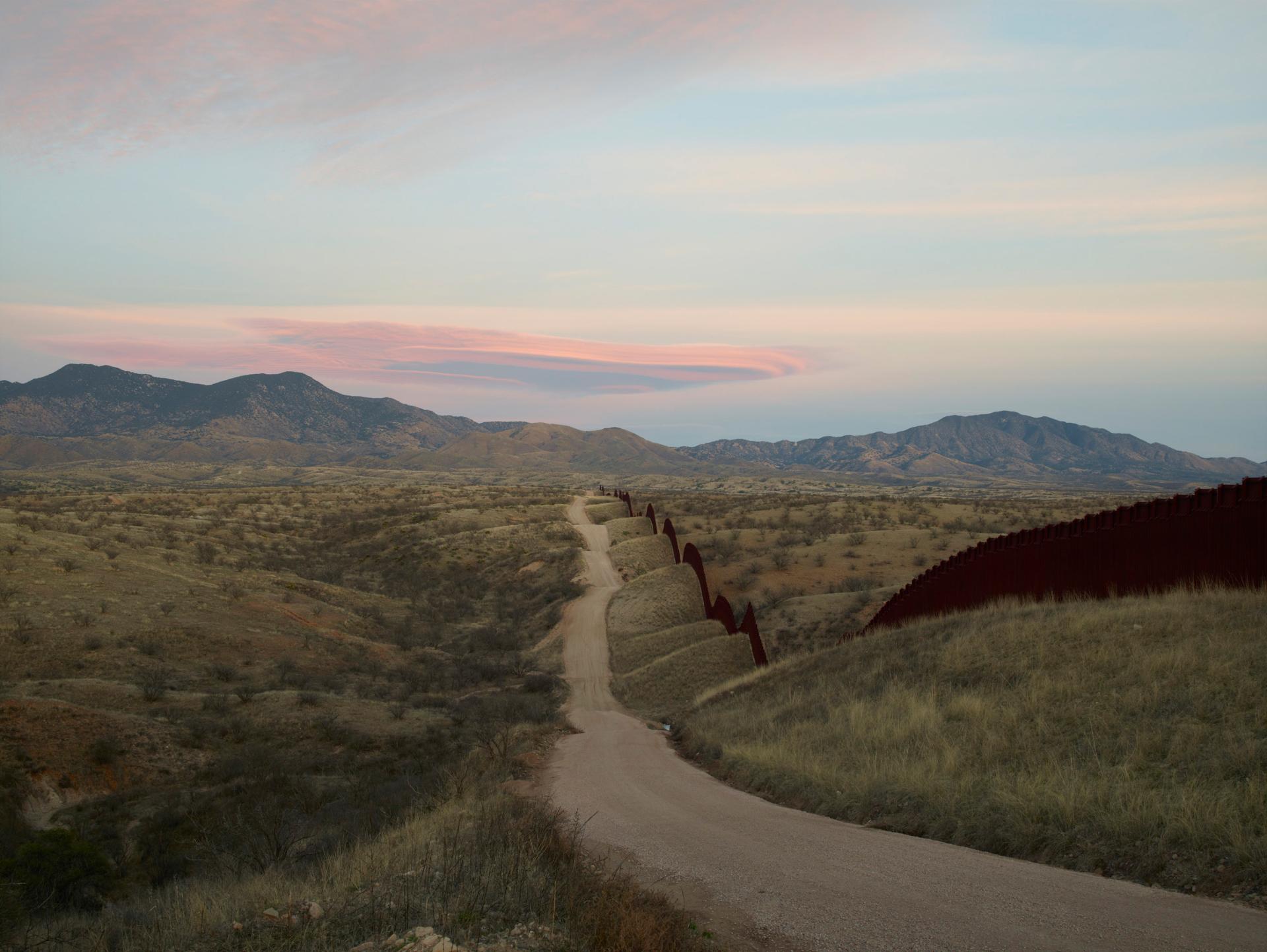In the desert outside of Arivaca, Arizona, just a few miles from the Mexican border, several plastic jugs hung from the branch of a tree against the backdrop of a low winter sun. Humanitarian aid workers had put them there, filled with water, for migrants making their way through the harsh, inhospitable terrain. But coming closer we could see that something was wrong. All of them had been slashed—by local militia groups, we were told, eager to protect the “homeland” by making survival as hard as possible for people crossing into the United States.
That was in the winter of 2015, while I was leading a group of my classmates on a trip run by the Ignatian Center for Jesuit Education at Santa Clara University to learn about immigration policy and its effects. Months later, while viewing Richard Misrach and Guillermo Galindo’s joint exhibit, Border Cantos, at the San Jose Museum of Art, the image of the slashed jugs came back to me. Border Cantos (now showing at the Pace Gallery in New York City through August 18) featured Misrach’s exhaustive collection of photographs from the U.S.-Mexico border, as well as recordings of Galindo’s musical compositions, played on instruments handmade from debris gathered in the area. The combination of image, sound, and sculpture summoned the same uneasiness and anger about the cruelty I’d witnessed in the Arizona desert.

Misrach is most famous for his large-format color photographs of deserts and natural disasters. This collection is made up of a number of series that thematically look at migration from different perspectives. In The Wall, Misrach captures wide-sweeping vistas of the American Southwest eerily bisected by manmade infrastructure. In one image, the border wall conforms to the rolling hills under the pink-and-blue sunset east of Nogales, Arizona, but even faced with this aesthetic beauty the viewer feels discomfort. The steel barrier doesn’t separate two distinct things; it just arbitrarily divides a once-unified land. The distinction between the U.S. and Mexico may seem clear from New York or San Francisco, but I could remember that in Nogales, it didn’t.
Another photograph, of a free-standing section of fence no more than fifteen yards wide and encircled by tire tracks, makes clear the absurdity of funding for border infrastructure. As roads, bridges, and public transportation crumble in our nation’s cities, money still goes to building barriers that are easily skirted. Other photos show rail ties, recycled from the “great” westward expansion that came at the expense of indigenous peoples and immigrant railroad workers, now serving as vehicle barricades. Helicopter landing pads from the Vietnam War are turned up on their sides to create makeshift fences. It is as if the sins of a nation are fused into the metal used to divide people today. The injustice I witnessed first-hand in the desert was now present here, in visual art.
In Misrach’s series Target Practice, photographs of simple human-shaped targets are riddled with bullet holes. Misrach ventured out to Border Patrol shooting ranges to capture these images. Piles of empty shells on the ground are juxtaposed with shredded paper figures hanging in the range. Suddenly the dehumanized nature of border militarization is real and right in front of you. Those targets are people, people with friends and families. That “target” could have been my father, classmate, cousin, or friend. It could have been any number of the immigrants that I know.
In Agua, blue cylinders reveal themselves among sweeping beige desert landscapes. These pops of color are water stations. Across a massive grid, taking up an entire gallery wall, we see these water-drop locations all across the southern border. From California to Texas, good-hearted people make an effort to protect human life and provide drink to the thirsty. Unfortunately there are also those who deliberately go out of their way to reject this idea of universal human dignity. One photograph, dissimilar from the rest, zooms in on the exterior of the container. The blue drum, painted orange and green, occupies the entire frame. The large swaths of color become almost akin to an abstract color field painting, hanging in contrast to the landscapes that fill out the rest of the series. As in a painting, much attention is paid to the surface, which here is perforated, uneven, gouged out. The container is shot-through; vigilantes destroyed this resource out of a prideful, nationalist sense of patriotism. In the next photograph, a grouping of stones in the formation of a cross marks the death of four migrants. It lays just a few feet away from the water station.
The self-described post-Mexican experimental composer Guillermo Galindo takes this same symbol of a vandalized water station and creates a sculptural sound installation entitled “Fuente de Lágrimas,” or fountain of tears. A blue drum is now hoisted above a sheet of metal. Water leaks out of the small holes. As the water hits the metal plate, a sound similar to rain occupies the space. At this scale, the sculpture has become a monument to the pain produced by the border. The active flow of water mirrors the cycles of violence and oppression caused by immigration policies.
Making art that deals with social justice is not easy. In recent months debates about race, class, appropriation, and censorship have dominated the art world. Controversies with the Whitney biennial, Jimmie Durham, and an installation at the Walker Art Center have all made major headlines. How then does an artist carefully walk the line of solidarity? Border Cantos is successful because it addresses these problems head-on. Appropriation in contemporary art is condemned; representation matters. By partnering Misrach and Galindo, this exhibit not only becomes more dynamic by including sound installation and sculpture, but it also gains cultural authenticity. Without Galindo, Misrach’s photographs could be read as opportunistic. He could be seen as speaking for those on the margins, instead of standing with them. What makes this body of his work so intriguing is the fact that it comes from the outside looking in. His perspective forces an American audience to contemplate their complicity with injustice.
Border Cantos is now showing at the Pace Gallery in New York City through August 18.
Please email comments to [email protected] and join the conversation on our Facebook page.
Previous Story
Consensus & Uncertainty at the Supreme Court
Next Story
What Historians Will Say about Francis
